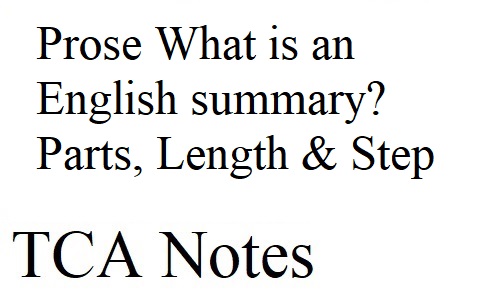Prose What is an English summary? Parts, Length & Step
To view Summary & Analysis of other prose. Click Here.
What is an English summary?
An English summary is a summary of a text that is written in such a way that it retains all the important information of the text but in a simple, easy-to-read way. The summary must be written in the same language as the original text, which means that the summary must be written in English if the original text was written in English. The summary should be as short and concise as possible. A good English summary contains only the essential information and no more.
How do you summarize in English?:
- Identify the most important points of the text and write them down on paper.
- Look up the terms and expressions you don't understand in a dictionary or a thesaurus.
- Make sure you understand the main idea of the text.
- Ask yourself what is the main point of the text.
- Write your own summary using the information you have just gathered.
- Read your summary aloud to see if it makes sense.
- Rewrite your summary until it is perfect.
What are the 5 parts of a summary?
- Introduction
- Thesis Statement
- Body Paragraph
- Conclusion
- References
What are the 5 parts of a summary?
A summary is the first impression that you make on your reader. You can't do anything about how they perceive you, but you can control what you say. When you write a summary, your goal is to say everything you need to say in just the right words. Your summary should be brief and to the point. It should be easy to read and understand. You should avoid lengthy explanations and repetitions.
- An introduction is where you introduce your topic. This is the most important part of the summary. The introduction tells the reader what your summary is about and how it will be organized.
- A thesis statement is a statement that summarizes the main idea of the summary. This is the main point or conclusion of the summary.
- Body paragraphs: This is where you explain your topic using evidence from the source. The body paragraphs are organized around the thesis statement.
- Conclusion: This is the final section of the summary. It summarizes the information in the body paragraphs and restates the thesis statement.
- References: At the end of the summary, you should list all of the sources used in your summary
How do you write a 50 word summary?
A 50 word summary is a summary that tries to give a strong idea of the main ideas of a paragraph. A good summary is concise and easy to read, and it should succeed at getting the reader interested in the rest of the paragraph. Here is how you can write 50 word summary of any topic:
- Start by listing the main ideas of your paragraph.
- Summarize the key points.
- Use one or two phrases to give the main ideas a voice.
- Use a verb as the most important word in the phrase.
- Use "and" rather than "but" as the connector between ideas.
- Write the summary so that it can stand on its own.
The best way to learn how to write a 50-word summary is to practice. Read some good summaries and try to write your own, then start from the beginning and work your way up to writing your first 50 words.
What are the 8 steps to writing a summary?
A summary is a written account of a text, film, or another type of source material. The purpose of a summary is to give readers a condensed version of the material. The summary is written by summarizing the source material.
- Define Problem: The problem is the main question or issue that your readers are trying to answer.
- Define Purpose of Summary: To help your readers understand what you are going to say.
- Identify Background Information: It is the knowledge that is needed to understand the question or issue.
- Identify Question or Issue: What is the question or issue that you want to answer?
- Select Evidence: Select the evidence that supports or answers the question or issue.
- Organize Evidence: Organize the evidence in a logical flow, starting with the most relevant first.
- Summarize Evidence: Summarize the evidence, including the strengths and weaknesses.
- Write Conclusion: Write a conclusion that will bring the reader back to the question or issue at hand.


